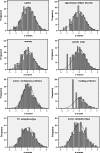Comorbid problems in ADHD: degree of association, shared endophenotypes, and formation of distinct subtypes. Implications for a future DSM
- PMID: 19308723
- PMCID: PMC2708322
- DOI: 10.1007/s10802-009-9312-6
Comorbid problems in ADHD: degree of association, shared endophenotypes, and formation of distinct subtypes. Implications for a future DSM
Abstract
We aimed to assess which comorbid problems (oppositional defiant behaviors, anxiety, autistic traits, motor coordination problems, and reading problems) were most associated with Attention-Deficit/Hyperactivity Disorder (ADHD); to determine whether these comorbid problems shared executive and motor problems on an endophenotype level with ADHD; and to determine whether executive functioning (EF)-and motor-endophenotypes supported the hypothesis that ADHD with comorbid problems is a qualitatively different phenotype than ADHD without comorbid problems. An EF-and a motor-endophenotype were formed based on nine neuropsychological tasks administered to 816 children from ADHD-and control-families. Additional data on comorbid problems were gathered using questionnaires. Results indicated that oppositional defiant behaviors appeared the most important comorbid problems of ADHD, followed by autistic traits, and than followed by motor coordination problems, anxiety, and reading problems. Both the EF-and motor-endophenotype were correlated and cross-correlated in siblings to autistic traits, motor coordination problems and reading problems, suggesting ADHD and these comorbid problems may possibly share familial/genetic EF and motor deficits. No such results were found for oppositional defiant behaviors and anxiety. ADHD in co-occurrence with comorbid problems may not be best seen as a distinct subtype of ADHD, but further research is warranted.
Figures
Similar articles
-
Hot and Cool Executive Functions in Children with Attention-Deficit/Hyperactivity Disorder and Comorbid Oppositional Defiant Disorder.J Int Neuropsychol Soc. 2015 Sep;21(8):584-95. doi: 10.1017/S1355617715000752. J Int Neuropsychol Soc. 2015. PMID: 26416095 Free PMC article.
-
Co-occurrence of motor problems and autistic symptoms in attention-deficit/hyperactivity disorder.J Am Acad Child Adolesc Psychiatry. 2008 Jun;47(6):662-672. doi: 10.1097/CHI.0b013e31816bff88. J Am Acad Child Adolesc Psychiatry. 2008. PMID: 18434922
-
Comorbid ADHD and mental health disorders: are these children more likely to develop reading disorders?Atten Defic Hyperact Disord. 2013 Mar;5(1):21-8. doi: 10.1007/s12402-012-0093-3. Epub 2012 Nov 4. Atten Defic Hyperact Disord. 2013. PMID: 23124818
-
Comorbidity of attention-deficit/hyperactivity disorder with psychiatric disorder: an overview.J Clin Psychiatry. 1998;59 Suppl 7:50-8. J Clin Psychiatry. 1998. PMID: 9680053 Review.
-
[Impact of comorbidity on the executive function of patients with attention deficit hyperactivity disorder (review)].Beijing Da Xue Xue Bao Yi Xue Ban. 2007 Jun 18;39(3):329-32. Beijing Da Xue Xue Bao Yi Xue Ban. 2007. PMID: 17572794 Review. Chinese.
Cited by
-
Brief Report: Adaptive Functioning in Children with ASD, ADHD and ASD + ADHD.J Autism Dev Disord. 2015 Jul;45(7):2235-42. doi: 10.1007/s10803-014-2352-y. J Autism Dev Disord. 2015. PMID: 25614019
-
Time perception, phonological skills and executive function in children with dyslexia and/or ADHD symptoms.J Child Psychol Psychiatry. 2011 Feb;52(2):195-203. doi: 10.1111/j.1469-7610.2010.02312.x. Epub 2010 Sep 23. J Child Psychol Psychiatry. 2011. PMID: 20860755 Free PMC article.
-
Speech-Sound Disorders and Attention-Deficit/Hyperactivity Disorder Symptoms.Top Lang Disord. 2012 Sep 1;32(3):247-263. doi: 10.1097/tld.0b013e318261f086. Top Lang Disord. 2012. PMID: 24363479 Free PMC article.
-
Relationship between symptom impairment and treatment outcome in children and adolescents with attention-deficit/hyperactivity disorder: a physician perspective.Atten Defic Hyperact Disord. 2015 Mar;7(1):75-87. doi: 10.1007/s12402-014-0143-0. Epub 2014 Aug 23. Atten Defic Hyperact Disord. 2015. PMID: 25148781 Free PMC article.
-
A New Spin on Spatial Cognition in ADHD: A Diffusion Model Decomposition of Mental Rotation.J Int Neuropsychol Soc. 2021 May;27(5):472-483. doi: 10.1017/S1355617720001198. Epub 2020 Dec 9. J Int Neuropsychol Soc. 2021. PMID: 33292918 Free PMC article.
References
-
- None
- American Psychiatric Association. (1994). Diagnostic and Statistical Manual for Mental Disorders (4th ed.). Washington, DC: American Psychiatric.
-
- {'text': '', 'ref_index': 1, 'ids': [{'type': 'DOI', 'value': '10.1111/1469-7610.00424', 'is_inner': False, 'url': 'https://doi.org/10.1111/1469-7610.00424'}, {'type': 'PubMed', 'value': '10102726', 'is_inner': True, 'url': 'https://pubmed.ncbi.nlm.nih.gov/10102726/'}]}
- Angold, A., Costello, E. J., & Erkanli, A. (1999). Comorbidity. Journal of Child Psychology and Psychiatry, and Allied Disciplines, 40, 57–87. doi:10.1111/1469-7610.00424. - PubMed
-
- {'text': '', 'ref_index': 1, 'ids': [{'type': 'DOI', 'value': '10.1111/j.1467-7687.2005.00400.x', 'is_inner': False, 'url': 'https://doi.org/10.1111/j.1467-7687.2005.00400.x'}, {'type': 'PubMed', 'value': '15720371', 'is_inner': True, 'url': 'https://pubmed.ncbi.nlm.nih.gov/15720371/'}]}
- Banaschewski, T., Hollis, C., Oosterlaan, J., Roeyers, H., Rubia, K., Willcutt, E., et al. (2005). Towards an understanding of unique and shared pathways in the psychopathophysiology of ADHD. Developmental Science, 8, 132–140. doi:10.1111/j.1467-7687.2005.00400.x. - PubMed
-
- {'text': '', 'ref_index': 1, 'ids': [{'type': 'DOI', 'value': '10.1037/0022-3514.51.6.1173', 'is_inner': False, 'url': 'https://doi.org/10.1037/0022-3514.51.6.1173'}, {'type': 'PubMed', 'value': '3806354', 'is_inner': True, 'url': 'https://pubmed.ncbi.nlm.nih.gov/3806354/'}]}
- Baron, R. M., & Kenny, D. A. (1986). The moderator-mediator variable distinction in social psychological research: conceptual, strategic, and statistical considerations. Journal of Personality and Social Psychology, 51, 1173–1182. doi:10.1037/0022-3514.51.6.1173. - PubMed
-
- {'text': '', 'ref_index': 1, 'ids': [{'type': 'DOI', 'value': '10.1007/s10802-007-9141-4', 'is_inner': False, 'url': 'https://doi.org/10.1007/s10802-007-9141-4'}, {'type': 'PMC', 'value': 'PMC3591788', 'is_inner': False, 'url': 'https://pmc.ncbi.nlm.nih.gov/articles/PMC3591788/'}, {'type': 'PubMed', 'value': '17505876', 'is_inner': True, 'url': 'https://pubmed.ncbi.nlm.nih.gov/17505876/'}]}
- Bauermeister, J. J., Shrout, P. E., Ramírez, R., Bravo, M., Alegría, M., Martínez-Taboas, A., et al. (2007). ADHD correlates, comorbidity, and impairment in community and treated samples of children and adolescents. Journal of Abnormal Child Psychology, 35, 883–898. doi:10.1007/s10802-007-9141-4. - PMC - PubMed
Publication types
MeSH terms
Grants and funding
LinkOut - more resources
Full Text Sources
Other Literature Sources
Medical


